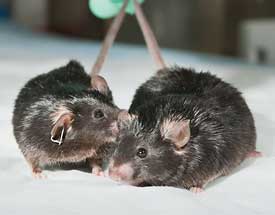U-M researchers have identified a gene that acts as a master switch to control obesity in mice. When the switch is turned off, even high-fat-diet mice remain thin.
Deleting the gene, called IKKE, also appears to protect mice against conditions that, in humans, lead to Type 2 diabetes, which is associated with obesity and is on the rise among Americans, including children and adolescents.

If follow-up studies show that IKKE is tied to obesity in humans, the gene and the protein it makes will be prime targets for the development of drugs to treat obesity, diabetes and complications associated with those disorders, says Alan Saltiel, the Mary Sue Coleman director of the Life Sciences Institute.
“We’ve studied other genes associated with obesity — we call them ‘obesogenes’ — but this is the first one we’ve found that, when deleted, stops the animal from gaining weight,” says Saltiel, senior author of a paper that appears in the Sept. 4 edition of the journal Cell.
“The fact that you can disrupt all the effects of a high-fat diet by deleting this one gene in mice is pretty interesting and surprising,” he says.
Obesity is associated with a state of chronic, low-grade inflammation that leads to insulin resistance, which is usually the first step in the development of Type 2 diabetes. In the Cell paper, Saltiel and his colleagues show that deleting, or “knocking out,” the IKKE gene not only protected high-fat-diet mice from obesity, it prevented chronic inflammation, a fatty liver and insulin resistance, as well.
The high-fat-diet mice were fed a lard-like substance with 45 percent of its calories from fat. Control mice were fed standard chow with 4.5 percent of its calories from fat. The dietary regimen began when the mice were 8 weeks old and continued for 14 to 16 weeks.
The gene IKKE produces a protein kinase also known as IKKE. Protein kinases are enzymes that turn other proteins on or off. The IKKE protein kinase appears to target proteins that, in turn, control genes that regulate the mouse metabolism.
When the high-fat diet is fed to a normal mouse, IKKE protein-kinase levels rise, the metabolic rate slows, and the animal gains weight. In that situation, the IKKE protein kinase acts as a brake on the metabolism.
Knockout mice placed on the high-fat diet did not gain weight, apparently because deleting the IKKE gene releases the metabolic brake, allowing it to speed up and burn more calories, instead of storing those calories as fat.
“The knockout mice are not exercising any more than the control mice used in the study. They’re just burning more energy,” Saltiel says. “And in the process, they’re generating a little heat, as well — their body temperature actually increases a bit.”
Saltiel’s team is now searching for small molecules that block IKKE protein-kinase activity.
“If you find an inhibitor of this protein kinase, you should be able to obtain the same effect as knocking out the gene. And that’s the goal,” Saltiel says. If successful candidates are identified and drug development is pursued, a new treatment for obesity and diabetes is likely a decade away, he says.
First author of the Cell paper is Shian-Huey Chiang of LSI. Co-authors are U-M researchers Merlijn Bazuine, Carey Lumeng, Lynn Geletka, Jonathan Mowers, Nicole White, Jing-Tyan Ma, Jie Zhou, Nathan Qi, Dan Westcott and Jennifer Delproposto.

